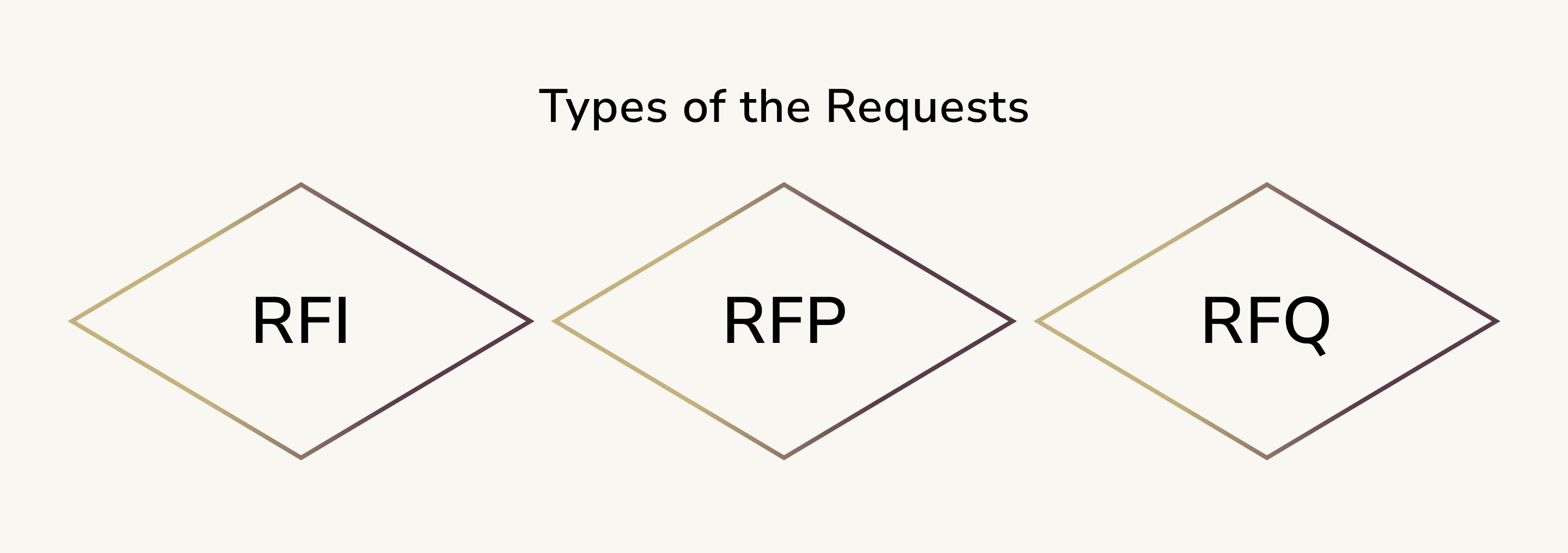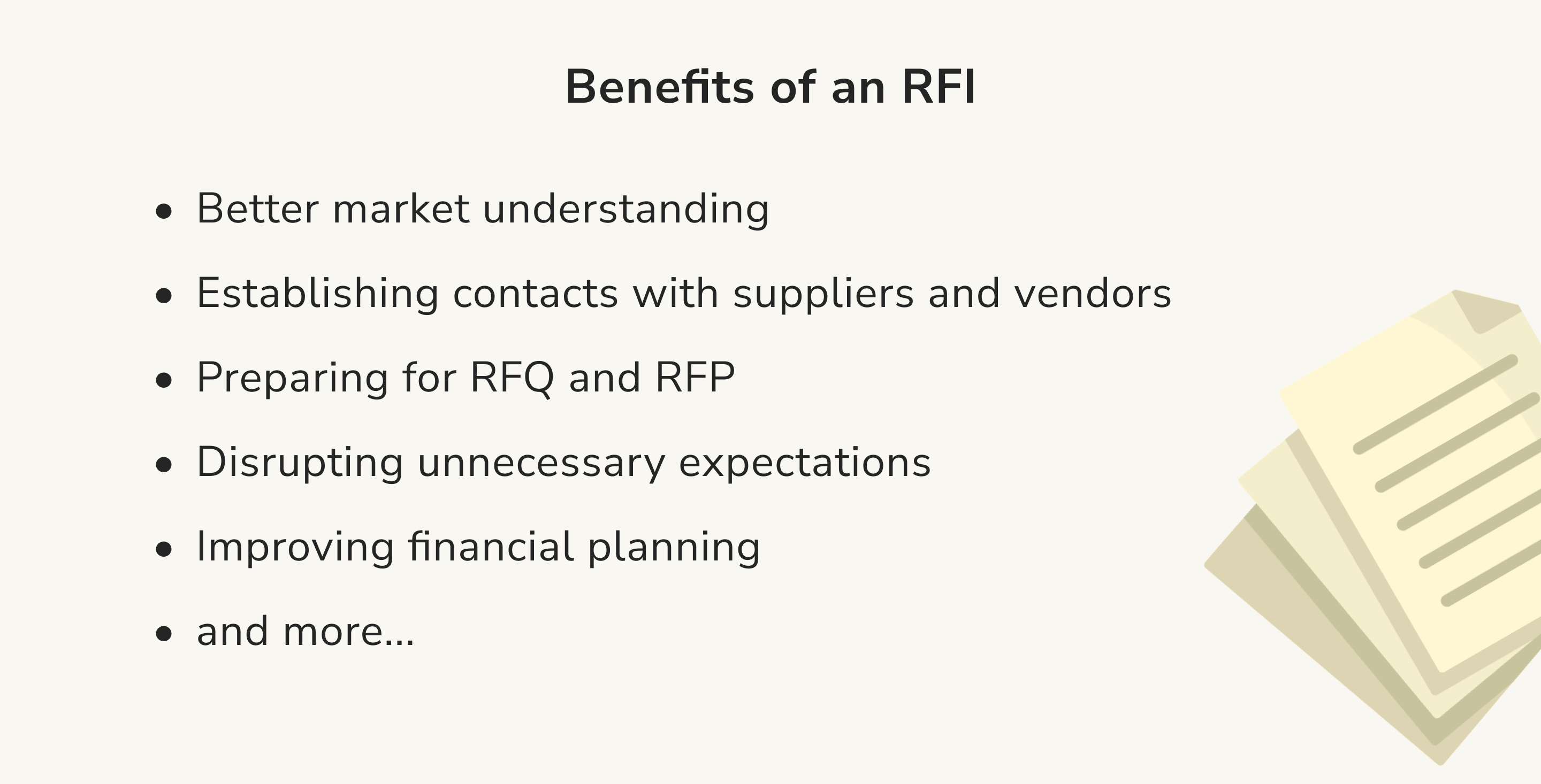Creating Perfect RFI: What to Include

If you found yourself reading this article, it means that you were looking for any information about the request for information (RFI). It doesn't matter if you are wondering what is an RFI or trying to learn how to write a request for information — we’ve got you covered.
A request for information form template can define whether you succeed in a new market or not. Information about various products is essential today.
If you have a business that wants to work with outside providers, this article is perfect for you. All people who need to know what is included in a formal request for information would find the material highly useful.
What is an RFI?
Understanding what RFI means is simple. The concept of the request for information stands for a process aimed at collecting basic information about some ware (or service) from the relevant suppliers. Thus, a basic RFI would always include some formal address.
The meaning of the request for information process in business is tremendous today. With this process, one can chart the future actions of their enterprise.
Let's imagine that you need to buy medical equipment. However, you don't know anything about vendors. The knowledge of what RFI stands for would help here.
You'll be able to quickly understand the market. A request for information would give you all the relevant information. Thus, we believe that you need to know how to write an RFI.
Many companies in the IT field use requests for information to understand the markets. Generally, a request for information in construction is a common use too. In reality, almost every field needs the knowledge of writing a request for information letter. Thus, you should start learning today. Without it, you can fall behind the competitors.
The Difference Between RFI, RFP, and RFQ
One should also not confuse RFI (request for information), RFP (request for proposal) and RFQ (request for quotation). So, what are RFP and RFI? Let's take a look! These concepts differ significantly!

Request for information vs request for proposal — as mentioned previously, RFI is a request for information from a customer to a supplier. Request for information is usually the preliminary stage of any negotiations.
An RFP is a rather similar document. However, it's much more detailed than the request for information. A request for proposal in information technology would give very thorough product descriptions. You can check our guide on RFPs to get a better understanding of the topic.
Request for information and request for proposal appear in different stages of the business’ developement. The former is about investigating the market. The latter helps with bidding. An RFP is about demands. You describe what you want from a product with clear purchase intent. Request for information helps learn about some wares without any commitments. Some use cases can help clarify the difference here:
- Let's imagine you need an antivirus program. However, you don't know anything about them and request for additional information. That's a perfect case for RFI.
- Your company already knows what it wants from a product. It seeks reliability and good virus databases. Here, a request for information form is not enough: you'll need an RFP.
What about the RFQ and RFI meaning? Here, the answers are rather simple too. An RFQ signifies a very detailed request for product prices. It's usually for something very specific and well-defined. Thus, the meaning of RFI is to help prepare for an RFQ. The difference here is similar to the RFP/RFI meaning divergence. Primarily, you send in the RFI to some businesses. Then, a request for additional information received by the company can help you produce an RFQ. It's also crucial to understand the difference between RFP and RFQ. RFI, RFP, and RFQ serve somewhat different goals. RFP is about the opportunities to know about a service; RFQ is aimed at finding out prices.
For instance, an RFI is necessary if you need to know about the PC components on the market. RFP details the need for some work (for instance, programming) and asks for solutions. Lastly, RFQ would help you find out the prices if you already know that you need PCs with some well-established characteristics.
In short, an RFI helps understand the market. RFP assists with investigating solutions to your problems. RFQ is used when you know solutions and only need to know how much one should pay.
Why do you need an RFI?
Now that we know the request for information meaning, let's transition to seeing some main uses for it. Primarily, you need to use an RFI to orient yourself in a new market. Request for information letters help you find out the main capabilities in some markets. Usually, you write them when the knowledge of the sector is low.
Let's imagine that you need proofreading technology. However, your company never worked with any proofreading (it can be in IT). You would need a request for information sample to address companies such as Grammarly.

Generally, an RFI can help your business in a myriad of ways today:
- The approach can disrupt unnecessary expectations. Companies tend to overestimate progress in some fields. Request for information usually resolves this issue by detailing capabilities.
- You can find out the main suppliers in the sector. A simple request for information email is enough to give you an insight into the main players within some sectors. In this way, you can avoid companies that don't fit your goals.
- RFI helps establish contacts with suppliers. Every relationship needs to start with a first step. A simple RFI template can be the beginning of a great business journey.
- RFI prepares you for an RFP and RFQ. Information that you get from suppliers is essential for future actions. RFP, RFQ, and RFI are realized only in combination.
- RFI is also essential for informing the top management. Sometimes, you don't need to enter some field. However, the RFI is to also help you gather data for your superiors.
- One can use RFI to understand the market too. RFQ and RFI meaning can also lie in learning about competition in general. Using this, you can cover the market gaps via some new offerings not available before.
- RFIs are also great for financial planning. A simple RFI form can give you lots of information on the feasibility of some projects. If you want to know the prices, writing an RFI is essential.
All in all, the RFI meaning is tremendous today. The long-term well-being of your business depends on this concept. Don't hesitate to learn about a standard RFI template.
What should be included in an RFI?
Let's take a look at the key elements that need inclusion within a request for information format. An average document of this type has several key elements.
Firstly, you should add a strong overview of the key information. Here, two essential elements are of the essence for a good example of request for information letter. In an overview section, one must give a description of the organization. For example, if you work in IT, describe the main goals of your organization in a detailed fashion. Software RFI template samples usually make this goal simple. What is more, you should actually say that the document is an RFI. A good purpose section is crucial here. A sample RFI response template would guide you here. This section should give basic information. After reading it, one should understand your goals. The meaning of RFI is low without such input.
Secondly, you should specify your request requirements. An RFI is pointless without this information. Every RFI template example shows that you need to say what information is requested. For example, let's imagine that you need to know product characteristics. RFI business meaning is to request this information. Many other options are possible. An RFI is perfect for learning about delivery. A vendor RFI should mention all you need.
Thirdly, you need to show your expectations. Describe what you want from a product. A sample RFI template must give criteria. In short, the RFI template sample should be very definite to give you key information.
Lastly, you should offer some clarification sections. Give some final details here. Any miscellaneous thing that affects the response to RFI template goes here. What to include in such a section? A good option is to say what you don't want to know. An RFI template for software development would need no information on the proofreading capabilities of some programs. If you have financial constraints or want simple functions, writing in this section is also a good idea. What is RFI, after all? It's a way to know about the key market opportunities.
Other specialists note additional elements. An RFI form template should have a confidentiality section. Why would you need it? There, one can describe the information that is sensitive. What RFI means is also an NDA. Why is that so? Let's recall what is RFI? It's an information document that features lots of sensitive data.
In this light, it's essential to preserve the safety of all parties. After you give a request for more information, a lot of production capability data appears. Hence, its leak to other parties should not happen. A good document should include a non-disclosure agreement. Parties need to sign an agreement that they won't give our relevant information from the request for information (RFI). After all, a leaked RFI can make any business extremely vulnerable today.
Besides, a key practice is to add contacts. Generally, an average IT RFI template should, for instance, hold a corporate email of a company and its address. In this way, partners would be able to contact you fast.
A request for information (RFI) needs to be speedy. Thus, your partners should have a convenient way to send in the relevant data. Ease-of-use is a sign of respect regarding any vendor RFI template. In this regard, our recommendation is to leave several channels for contact. Communication methods sometimes fail. Hence, an RFI template for IT services, for example, should have the address, email, and telephone numbers.
Some best practices for such documents exist. An RFI cover letter template should follow standards. Primarily, you should limit the scope of the requested information. An RFI must not ask more than needed. It's crucial to save time and highlight that you're not spying.
What is more, you need to be very specific about the necessary information. Clearly ask for the data you want to see. The only factor here is not to become too fanatical with RFI details.
A good idea is to also think about time. The request for information samples need some time for getting filled. Thus, give a week or two for them; your partners should have some space.
Don't focus on prices or highly specific information. Let's remember what is RFI and RFP. The former is crucial only for getting information; the latter shows that you want to buy something.
Generally, you should structure an RFI in a way that would not confuse the partners about your intent to buy. A good request for information would always be very limited in its ambition. You should clearly show that only information is necessary.
Lastly, a strong idea is to focus on simple templates. RFI form templates are common. Use the options recommended by specialists. Templates of this kind are usually well-tested. You can find an RFI template PDF, for example.
All in all, as you may see, writing an RFI is not difficult. You simply need to know the structure and key rules. Modern RFI email template samples would do the rest of the job.
RFI Template
An important aspect to know is the overall structure of an RFI. Some great examples are present on the Internet. Let's take a look at the RFI form template samples.
You can find great samples here and here. They have high-quality forms for the users. Our recommendation is to model an RFI template Word document after those sources.
Above all, we recommend presenting a request for information template PDF as a table. In such a structure, it should be easier to write in the relevant information.
An average partner would quickly orient themselves in the structure. Besides, it would enable both written and printed responses. Thus, requests for information RFI benefits from modern document creation capabilities. The general structure one should use is simple. Start with the name of the document at the top. A good practice is submitting RFI meaning in such cases. Then, add rows that describe the date of request provision and the expected answer period. This information at the top should give a clear sense of a deadline. Request for information template PDF is, after all, about getting information fast. A good idea is to also add company names at the top. Describe who gets the request for information letter template. Then, showcase the sender.
Once you give some key descriptions of this type, proceed with the RFI request data. Adding a request for information line (RFI) is essential. There, you'll be able to give the key data on your request. The field in question can have several mini parts. Firstly, giving company data in the request for information template email is essential. Describe what your firm does.
Secondly, add a line with a clear request on the scope of information. RFI template Excel file (any format would do), for example, should show what you need. Let's review an example in IT. First, you should describe that your company develops some software. Then, ask whether a partner company would be able to cover some of your needs (testing automation, for instance).
Here, a good idea is to also add a field for attachments. RFI template construction samples recommend that you add some important documents under the scope of information requests. Thus, adding a field of this type to your document is essential.
Our recommendation is to also add the clarification section here. Show your expectation for the RFI response. Besides, a strong idea is to describe what you don't want to see. Generally, the idea is to give as much space for information as possible. A request for information should be informative. Once your readers see it, they should have a clear idea of the request.
Thirdly, a good practice is to offer a clear field for the responses. Give a full-scale space in the RFI document template here. The response should be as detailed as possible. Here, some subspaces may be essential, however. Firstly, prepare a section with a company name. You should know who is responding to a request for information. Secondly, a good idea is to leave a section for product description. Response to a request for information should be easy to follow. This section must give you the key information. Some request for information sample questions can also work in this case. If you have a set of predetermined questions, put them inside. A request for information response would benefit from such clarity.
Lastly, a good document of this kind should have contact information. Put in your address, phone, and email at the bottom. A formal request for information would require a clear space for this data.
Generally, a request for information is a rather short document. Your description should not take more than 2-3 pages. Similarly, the response must be short too. Expect 2-3 pages as well. Professional email request for information is about giving general data.
One of the biggest pitfalls is asking for too much information. How to request for information? Be very conservative in your activities. The document must not create an impression that you have a purchase intention. Treat it as a market review. They give you data on the products without any binding agreements. We also recommend paying attention to style. A strong request for information example is easy to read and use.
A good idea is to use traditional fonts. Options such as Times New Roman or Arial are great. Request for additional information letter should take eyesight comfort into consideration. The sizes for such fonts should also be readable. Request for information template Word file can benefit from 12- or 14-point fonts. A balance between information and convenience is necessary. Before sending anything, ask your colleagues to look at the readability of the sample letter of request for information.
As for the language, it should be formal. Do not use contracted forms (you're, they're, for example). In the request for additional information letter, address the partners with clear titles and utilize polite modal verbs (could you/would you, please).
Good practice in a sample letter of request for information is to use bullet points. This approach would make most of your letters more readable too.
Conclusion
To summarize, writing a sample of request for information is not difficult. Documents of this type are usually straightforward.
You should remember that a request for information letter sample is a preliminary document. In it, you simply ask for information. It doesn't give detailed purchase data. Hence, sending a request for information to many companies is a good idea. This document can give you maximum insights. If you need any help, addressing us is a great idea.
Knowing how to write request for information letters is essential. The practice can give information and establish company contacts. Don't hesitate to start learning today.

Roman Zomko
Other articles